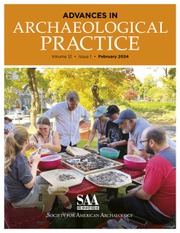Article contents
Assessing Terrestrial Laser Scanning in Complex Environments
An Approach from the Ancient Maya Site of Pacbitun, Belize
Published online by Cambridge University Press: 16 January 2017
Abstract
The majority of terrestrial scanning projects in archaeology have focused on heritage documentation, preservation, and the three-dimensional (3D) reconstruction of prominent sites and objects. While these are very important archaeological foci, not many have used terrestrial scanning methods for prospection and feature analysis, similar to the way many have employed airborne LiDAR. While airborne LiDAR scanning is able to situate and analyze archaeological sites on an expansive scale, the ground-based method also captures and defines any landscape anomalies or depressions from cultural features that have remained invisible to the naked eye due to environmental restrictions. In an attempt to test this recording method, we set out to paint a non-invasive, 3D digitized picture of the ancient Maya site of Pacbitun, Belize, using terrestrial scanning to distinctly detail Pacbitun’s structures, plazas, causeways, and karst features. This paper details the process through which 3D terrestrial scanning was executed at Pacbitun and three associated peripheral caves during the 2012 and 2013 field seasons. We discuss the potential laser scanning has for visual analysis in archaeology and evaluate application difficulties encountered in the field, as well as current data interpretation issues.
Hasta la fecha, la mayoría de los proyectos de exploración terrestre en arqueología se han centrado en la documentación del patrimonio, la conservación y/o la reconstrucción tridimensional de sitios destacados, así como el modelaje de objetos. Si bien éstos son importantes focos arqueológicos, pocos proyectos han utilizado métodos de exploración terrestre para la prospección y análisis de elementos de manera similar a la forma en que muchos han empleado LiDAR aéreo. Mientras que la exploración aérea LiDAR es capaz de situar y analizar sitios arqueológicos a una escala amplia, el método terrestre también captura y define cualquier anomalía o depresiones en el paisaje como producto de las características culturales que han permanecido invisibles a simple vista debido a restricciones ambientales. En un intento de probar este método de registro, nos propusimos producir una imagen digitalizada tridimensional no invasiva del antiguo sitio Maya de Pacbitun, Belice, utilizando la exploración terrestre para detallar claramente las estructuras, plazas, calzadas, y características kársticas de Pacbitun. En este trabajo se detalla el proceso a través del cual se ejecutó la exploración terrestre 3D en Pacbitun y en tres cuevas periféricas asociadas durante las temporadas de campo de 2012 y 2013. Se discute el potencial que tiene el escaneo láser para el análisis visual en arqueología y para evaluar las dificultades de aplicación que se encuentran en el campo, así como los problemas actuales en la interpretación de datos.
Information
- Type
- Research Article
- Information
- Copyright
- Copyright © Society for American Archaeology 2014
References
References Cited
- 7
- Cited by

